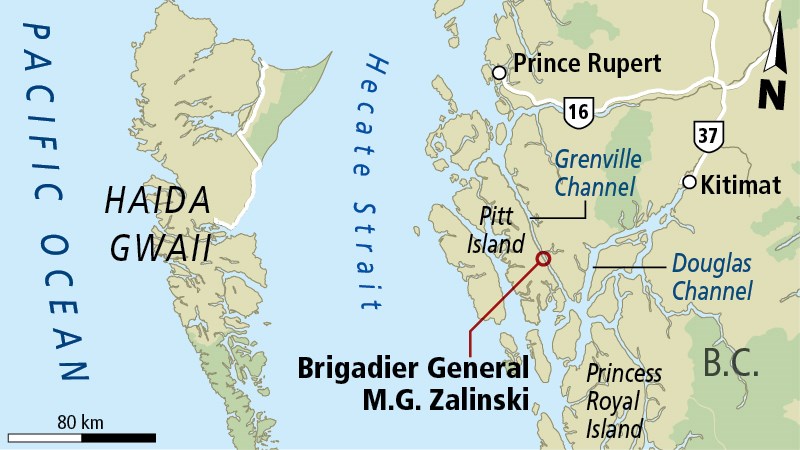 They sucked 43 tonnes of oil out of the sunken Brigadier General M.G. Zalinski, far less than expected.
They sucked 43 tonnes of oil out of the sunken Brigadier General M.G. Zalinski, far less than expected.
Doesn’t seem like much for $30 million, but then governments could argue scooping the goop was just one reason to tackle the 67-year-old shipwreck. The real benefit of the two-month clean-up, which concluded just before Christmas, was in improving disaster-response capabilities on the B.C. coast — which, you might have noticed, is a ticklish issue as we wrestle with the Northern Gateway proposal to ship Alberta bitumen out of Kitimat by tanker.
The Zalinski was a U.S. army transport ship that hit the rocks in 1946 while en route from Seattle to Alaska. It sank in Grenville Channel, 100 kilometres south of Prince Rupert, coming to rest upside down on a shelf 40 metres down. The crew of 48 was rescued by a tug and the passenger ship SS Catala.
The wreck was largely forgotten until 2003, when a passing U.S. Coast Guard ship noticed an oil slick. Despite attempts to patch the vessel’s corroding hull, it continued to burp up fuel with increasing frequency until last spring, when Ottawa decided to clean it up once and for all. Not knowing how much fuel was trapped inside, some called it a time bomb.
In October, an instant village emerged in the middle of nowhere — cell towers built on the mountains, barges (including one with a helicopter pad) dragged in, more than 100 workers living in what would normally be floating fishing lodges.
Led by the Canadian Coast Guard, it was a massive, multi-agency effort: Transport Canada, Health Canada, Fisheries and Oceans, B.C. Parks, the federal and provincial environment ministries, First Nations, three big contractors — Western Canadian Marine Response, Global Diving, Dutch salvage specialists Mammoet — and a bunch of smaller ones.
“It was a fascinating project,” says coast guard assistant commissioner Roger Girouard.
They started the operation worried about the fragility of the Zalinski’s outer hull, but found it was the interior metal that had truly eroded. The fuel tanks weren’t sound — one wall had collapsed completely — meaning oil had migrated throughout the ship. Divers had to poke into the nooks and crannies to vacuum it up.
With the fuel tanks holed, salvers had to abandon plans to recover the oil through “hot tapping” — a process in which the oil is blasted loose with pressurized hot water. Instead, the gunk was sucked up through hoses. They recovered 44,000 litres of oil — roughly 43 tonnes of thick, black bunker fuel, enough to fill a standard shipping container — and another 319,000 litres of oily water.
That’s less than expected.
The Zalinski had a maximum capacity of 700 tonnes of fuel (though it probably had less than that when it left Seattle). Girouard says much of the bunker C probably spilled when the ship went down; locals say shellfish beds were soiled for several years after the sinking, and there was a jump in cancer deaths in the late 1940s.
The Zalinski’s cargo included bombs, some of which divers spotted under the hull encrusted in cold-water coral.
None were scattered on the open ocean floor. Chemicals had leaked out the seams of some, so sea cucumbers and mussels were tested for contamination; one sample showed a barely measurable spike for one element, but that was it. When it was determined that the unexploded bombs were not a health issue, they were left to rust away.
The job was done on time, without hurting people or the environment, and well under its $50 million budget.
“We’re certainly going to be under 30 million and probably under 27,” Girouard said.
Still, the project was greeted with skepticism by critics who contend Ottawa found it necessary only after seeing the need to calm B.C.’s fears over the shipping of Northern Gateway oil. Girouard says there’s more to it than that.
“Was Zalinski driven by Kitimat? Not specifically.” With or without Alberta oil, B.C.’s northern waters are getting busier — everything from cruise ships and increased container traffic into Prince Rupert to all the fuel barges serving coastal communities, he said.
Working with other agencies — bringing together disparate organizations with differing agendas, rules and ways of operating — and running the show through a new Prince Rupert-based incident command system improved the coast guard’s ability to lead the response to any sort of spill, he says.
“It’s kind of like when you go to the gym. The workout is of value in itself, but it’s also the long-term investment that you’re making.”



